Intuitionistic type theory: Difference between revisions
en>Adavidb m Disambiguate Conjunction to Logical conjunction using popups; formatting: 7x heading-style, HTML entity (using Advisor.js) |
en>Daira Hopwood disambiguate intensional |
||
| Line 1: | Line 1: | ||
The | '''Gel permeation chromatography''' (GPC) is a type of [[size exclusion chromatography]] (SEC), that separates [[analyte]]s on the basis of size. The technique is often used for the analysis of [[polymers]]. As a technique, SEC was first developed in 1955 by Lathe and Ruthven.<ref name=Lathe>Lathe, G.H.; Ruthven, C.R.J. The Separation of Substance and Estimation of their Relative Molecular Sizes by the use of Columns of Starch in Water. ''Biochem J.'' '''1956''', ''62'', 665–674. PMID 13249976</ref> The term gel permeation chromatography can be traced back to J.C. Moore of the [[Dow Chemical Company]] who investigated the technique in 1964 and the proprietary column technology was licensed to [[Waters Corporation]], who subsequently commercialized this technology in 1964.<ref name=Moore>Moore, J.C. Gel permeation chromatography. I. A new method for molecular weight distribution of high polymers. ''J. Polym. Sci.'', '''1964''', ''2'', 835-843.[http://www3.interscience.wiley.com/cgi-bin/fulltext/104042350/PDFSTART ] {{doi|10.1002/pol.1964.100020220}}</ref> GPC systems and consumables are now also available from a numbers of manufacturers, including [[Agilent Technologies]]. It is often necessary to separate polymers, both to analyze them as well as to purify the desired product. | ||
When characterizing polymers, it is important to consider the [[polydispersity index]] (PDI) as well the [[molecular weight]]. Polymers can be characterized by a variety of definitions for molecular weight including the number average molecular weight (M<sub>n</sub>), the weight average molecular weight (M<sub>w</sub>) (see [[molar mass distribution]]), the size average molecular weight (M<sub>z</sub>), or the viscosity molecular weight (M<sub>v</sub>). GPC allows for the determination of PDI as well as M<sub>v</sub> and based on other data, the M<sub>n</sub>, M<sub>w</sub>, and M<sub>z</sub> can be determined. | |||
==How GPC Works== | |||
GPC separates based on the size or [[Hydrodynamic radius|hydrodynamic volume]] ([[radius of gyration]]) of the analytes. This differs from other separation techniques which depend upon chemical or physical interactions to separate analytes.<ref name=Skoog>Skoog, D.A. ''Principles of Instrumental Analysis'', 6th ed.; Thompson Brooks/Cole: Belmont, CA, 2006, Chapter 28.</ref> Separation occurs via the use of porous beads packed in a column (see [[stationary phase (chemistry)]]). [[Image:Pore size schematic.jpg|thumb|175px|left|Schematic of pore vs. analyte size]]The smaller analytes can enter the pores more easily and therefore spend more time in these pores, increasing their retention time. Conversely, larger analytes spend little if any time in the pores and are eluted quickly. All columns have a range of molecular weights that can be separated.[[Image:Size Limits for GPC.jpg|thumb|290px|right|Range of molecular weights that can be separated for each packing material]] If an analyte is either too large or too small it will be either not retained or completely retained respectively. Analytes that are not retained are eluted with the free volume outside of the particles (V<sub>o</sub>), while analytes that are completely retained are eluted with volume of solvent held in the pores (V<sub>i</sub>). The total volume can be considered by the following equation, where V<sub>g</sub> is the volume of the polymer gel and V<sub>t</sub> is the total volume:<ref name=Skoog /> <math>Vt=Vg+Vi+Vo</math> | |||
As can be inferred, there is a limited range of molecular weights that can be separated by each column and therefore the size of the pores for the packing should be chosen according to the range of molecular weight of analytes to be separated. For polymer separations the pore sizes should be on the order of the polymers being analyzed. If a sample has a broad molecular weight range it may be necessary to use several GPC columns in tandem with one another to fully resolve the sample. | |||
==Application== | |||
GPC is often used to determine the relative molecular weight of polymer samples as well as the distribution of molecular weights. What GPC truly measures is the [[molecular volume]] and shape function as defined by the [[intrinsic viscosity]]. If comparable standards are used, this relative data can be used to determine molecular weights within ± 5% accuracy. [[Polystyrene]] standards with PDI of less than 1.2 are typically used to calibrate the GPC.<ref name=Sandler>Sandler, S.R.; Karo, W.; Bonesteel, J.; Pearce, E.M. ''Polymer Synthesis and Characterization: A Laboratory Manual''; Academic Press: San Diego, 1998.</ref> Unfortunately, polystyrene tends to be a very linear polymer and therefore as a standard it is only useful to compare it to other polymers that are known to be linear and of relatively the same size. | |||
==Material and Methods== | |||
===Instrumentation=== | |||
<div style="float:left;width:350px;"> | |||
[[Image:GPC instrument.jpg|thumb|300px|none|A typical Waters GPC instrument including A. sample holder, B.Column C.Pump D. Refractive Index Detector E. UV-vis Detector]] | |||
[[Image:sample holder.jpg|thumb|300px|none|The inside of sample holder of Waters GPC instrument]] | |||
</div> | |||
Gel permeation chromatography is conducted almost exclusively in [[chromatography]] columns. The experimental design is not much different from other techniques of [[liquid chromatography]]. Samples are dissolved in an appropriate solvent, in the case of GPC these tend to be organic solvents and after filtering the solution it is injected onto a column. A Waters GPC instrument is shown to the left. The separation of multi-component mixture takes place in the column. The constant supply of fresh eluent to the column is accomplished by the use of a pump. Since most analytes are not visible to the naked eye a detector is needed. Often multiple detectors are used to gain additional information about the polymer sample. The availability of a detector makes the fractionation convenient and accurate. | |||
===Gel=== | |||
[[Gel]]s are used as stationary phase for GPC. The pore size of a gel must be carefully controlled in order to be able to apply the gel to a given separation. Other desirable properties of the gel forming agent are the absence of ionizing groups and, in a given solvent, low affinity for the substances to be separated. Commercial gels like PLgel, [[Sephadex]], Bio-Gel ([[cross-linked]] [[polyacrylamide]]), [[agarose gel]] and Styragel are often used based on different separation requirements.<ref name=Helmut>Helmut, D. ''Gel Chromatography, Gel Filtration, Gel Permeation, Molecular Sieves: A Laboratory Handbook''; Springer-Verlag, 1969.</ref> | |||
===Eluent=== | |||
The [[eluent]] (mobile phase) should be a good solvent for the polymer, should permit high detector response from the polymer and should wet the packing surface. The most common eluents in for polymers that dissolve at room temperature GPC are [[tetrahydrofuran]] (THF), ''o''-[[dichlorobenzene]] and [[trichlorobenzene]] at 130–150 °C for crystalline [[polyalkyne]]s and ''m''-[[cresol]] and ''o''-[[chlorophenol]] at 90 °C for crystalline condensation polymers such as [[polyamide]]s and [[polyester]]s. | |||
===Pump=== | |||
There are two types of pumps available for uniform delivery of relatively small liquid volumes for GPC: piston or peristaltic pumps. | |||
===Detector=== | |||
In GPC, the concentration by weight of polymer in the eluting solvent may be monitored continuously with a detector. There are many detector types available and they can be divided into two main categories. The first is concentration sensitive detectors which includes UV absorption, differential refractometer (DRI) or refractive index (RI) detectors, infrared (IR) absorption and density detectors. Molecular weight sensitive detectors include low angle light scattering detectors (LALLS), multi angle light scattering (MALLS).<ref name=Trathnigg>Trathnigg, B. Determination of MWD and Chemical Composition of Polymers by Chromatographic Techniques. ''Prog. Polym. Sci.'' '''1995''', ''20'', 615-650.[http://www.sciencedirect.com/science?_ob=MImg&_imagekey=B6TX2-3YCDW2F-C-1&_cdi=5578&_user=99318&_orig=search&_coverDate=12%2F31%2F1995&_sk=999799995&view=c&wchp=dGLzVtz-zSkWA&md5=752a5001c8e7a52bd9aadd999673ed57&ie=/sdarticle.pdf ] {{doi|10.1016/0079-6700(95)00005-Z}}</ref> The resulting chromatogram is therefore a weight distribution of the polymer as a function of retention volume. [[Image:GPC Chromatogram.jpg|thumb|600px|center|GPC Chromatogram; V<sub>o</sub>= no retention, V<sub>t</sub>= complete retention, A and B = partial retention]]The most sensitive detector is the differential UV photometer and the most common detector is the differential refractometer (DRI). When characterizing copolymer, it is necessary to have two detectors in series.<ref name=Sandler /> For accurate determinations of copolymer composition at least two of those detectors should be concentration detectors.<ref name=Trathnigg /> The determination of most copolymer compositions is done using UV and RI detectors, although other combinations can be used.<ref name=Pasch>Pasch, H. Hyphenated Techniques in Liquid Chromatography of Polymers. ''Adv. Polym. Sci.'' '''2000''', ''150'', 1-66.[http://www.springerlink.com/content/75w211mepm23dxmt/fulltext.pdf ] {{doi|10.1007/3-540-48764-6}}</ref> | |||
==Data Analysis== | |||
Gel permeation chromatography (GPC) has become the most widely used technique for analyzing polymer samples in order to determine their molecular weights and weight distributions. Examples of GPC chromatograms of polystyrene samples with their molecular weights and PDIs are shown on the left. | |||
<div style="float:left;width:300px;"> | |||
[[Image:Anionic Polystyrene GPC Spectrum.jpg|thumb|280px|none|GPC Separation of Anionically Synthesized Polystyrene; M<sub>n</sub>=3,000 g/mol, PDI=1.32]] | |||
[[Image:Free Radical Polystyrene GPC.jpg|thumb|280px|none|GPC Separation of Free-Radical Synthesized Polystyrene; M<sub>n</sub>=24,000 g/mol, PDI=4.96]] | |||
</div> | |||
[[Image:Size exclusion standardisation.png|thumb|right|250 px|Standardization of a size exclusion column.]] Benoit and co-workers proposed that the hydrodynamic volume, V<sub>η</sub>, which is proportional to the product of [η] and M, where [η] is the intrinsic viscosity of the polymer in the SEC eluent, may be used as the universal calibration parameter. If the Mark-Houwink-Sakurada constants K and α are known (see [[Mark-Houwink equation]]), a plot of log [η]M versus elution volume (or elution time) for a particular solvent, column and instrument provides a universal calibration curve which can be used for any polymer in that solvent. By determining the retention volumes (or times) of monodisperse polymer standards (e.g. solutions of monodispersed polystyrene in THF), a calibration curve can be obtained by plotting the logarithm of the molecular weight versus the retention time or volume. Once the calibration curve is obtained, the gel permeation chromatogram of any other polymer can be obtained in the same solvent and the molecular weights (usually M<sub>n</sub> and M<sub>w</sub>) and the complete molecular weight distribution for the polymer can be determined. A typical calibration curve is shown to the right and the molecular weight from an unknown sample can be obtained from the calibration curve. | |||
==Advantages of GPC== | |||
As a separation technique GPC has many advantages. First of all, it has a well-defined separation time due to the fact that there is a final elution volume for all unretained analytes. Additionally, GPC can provide narrow bands, although this aspect of GPC is more difficult for polymer samples that have broad ranges of molecular weights present. Finally, since the analytes do not interact chemically or physically with the column, there is a lower chance for analyte loss to occur.<ref name=Skoog /> For investigating the properties of polymer samples in particular, GPC can be very advantageous. GPC provides a more convenient method of determining the molecular weights of polymers. In fact most samples can be thoroughly analyzed in an hour or less.<ref name=Cowie>Cowie, J.M.G.; Arrighi, V. ''Polymers: Chemistry and Physics of Modern Materials'', 3rd ed. CRC Press, '''2008'''.</ref> Other methods used in the past were fractional extraction and fractional precipitation. As these processes were quite labor intensive molecular weights and mass distributions typically were not analyzed.<ref name=Odian>Odian G. ''Principles of Polymerization'', 3rd ed.; Wiley Interscience Publication, 1991.</ref> Therefore, GPC has allowed for the quick and relatively easy estimation of molecular weights and distribution for polymer samples | |||
==Disadvantages of GPC== | |||
There are disadvantages to GPC, however. First, there is a limited number of peaks that can be resolved within the short time scale of the GPC run. Also, as a technique GPC requires around at least a 10% difference in molecular weight for a reasonable resolution of peaks to occur.<ref name=Skoog /> In regards to polymers, the molecular masses of most of the chains will be too close for the GPC separation to show anything more than broad peaks. Another disadvantage of GPC for polymers is that filtrations must be performed before using the instrument to prevent dust and other particulates from ruining the columns and interfering with the detectors. Although useful for protecting the instrument, the pre-filtration of the sample has the possibility of removing higher molecular weight sample before it can be loaded on the column. Another possibility to overcome these issues is the separation by [[Field flow fractionation|Field-flow fractionation]] (FFF). | |||
==Orthogonal Methods== | |||
[[Field flow fractionation|Field-flow fractionation]] (FFF) can be considered as an alternative to GPC. Especially when particles or high molar mass polymers causing clogging of the column, shear degradation is an issue or agglomeration takes place but cannot made visible will be the solution. FFF is separating in an open flow channel without having a static phase involved so no interactions occur. With one Field-Flow Fractionation version the Thermal Field-Flow Fractionation separation of polymers having same size but different chemical composition is possible<ref> Thermal Field-Flow Fractionation: Ultra-Broad Polymer Separation | http://www.chemeurope.com/en/products/77045/thermal-field-flow-fractionation-ultra-broad-polymer-separation.html </ref> is possible. | |||
==References== | |||
{{reflist}} | |||
[[Category:Chromatography]] | |||
[[Category:Polymers]] | |||
[[Category:Polyolefins]] | |||
[[ja:クロマトグラフィー#分子排斥クロマトグラフィー]] | |||
Revision as of 22:32, 21 October 2013
Gel permeation chromatography (GPC) is a type of size exclusion chromatography (SEC), that separates analytes on the basis of size. The technique is often used for the analysis of polymers. As a technique, SEC was first developed in 1955 by Lathe and Ruthven.[1] The term gel permeation chromatography can be traced back to J.C. Moore of the Dow Chemical Company who investigated the technique in 1964 and the proprietary column technology was licensed to Waters Corporation, who subsequently commercialized this technology in 1964.[2] GPC systems and consumables are now also available from a numbers of manufacturers, including Agilent Technologies. It is often necessary to separate polymers, both to analyze them as well as to purify the desired product.
When characterizing polymers, it is important to consider the polydispersity index (PDI) as well the molecular weight. Polymers can be characterized by a variety of definitions for molecular weight including the number average molecular weight (Mn), the weight average molecular weight (Mw) (see molar mass distribution), the size average molecular weight (Mz), or the viscosity molecular weight (Mv). GPC allows for the determination of PDI as well as Mv and based on other data, the Mn, Mw, and Mz can be determined.
How GPC Works
GPC separates based on the size or hydrodynamic volume (radius of gyration) of the analytes. This differs from other separation techniques which depend upon chemical or physical interactions to separate analytes.[3] Separation occurs via the use of porous beads packed in a column (see stationary phase (chemistry)).

The smaller analytes can enter the pores more easily and therefore spend more time in these pores, increasing their retention time. Conversely, larger analytes spend little if any time in the pores and are eluted quickly. All columns have a range of molecular weights that can be separated.
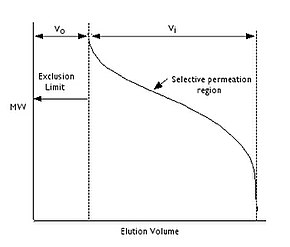
If an analyte is either too large or too small it will be either not retained or completely retained respectively. Analytes that are not retained are eluted with the free volume outside of the particles (Vo), while analytes that are completely retained are eluted with volume of solvent held in the pores (Vi). The total volume can be considered by the following equation, where Vg is the volume of the polymer gel and Vt is the total volume:[3]
As can be inferred, there is a limited range of molecular weights that can be separated by each column and therefore the size of the pores for the packing should be chosen according to the range of molecular weight of analytes to be separated. For polymer separations the pore sizes should be on the order of the polymers being analyzed. If a sample has a broad molecular weight range it may be necessary to use several GPC columns in tandem with one another to fully resolve the sample.
Application
GPC is often used to determine the relative molecular weight of polymer samples as well as the distribution of molecular weights. What GPC truly measures is the molecular volume and shape function as defined by the intrinsic viscosity. If comparable standards are used, this relative data can be used to determine molecular weights within ± 5% accuracy. Polystyrene standards with PDI of less than 1.2 are typically used to calibrate the GPC.[4] Unfortunately, polystyrene tends to be a very linear polymer and therefore as a standard it is only useful to compare it to other polymers that are known to be linear and of relatively the same size.
Material and Methods
Instrumentation
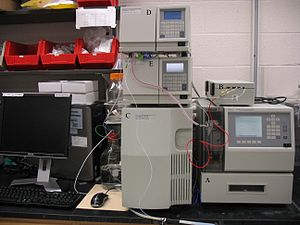

Gel permeation chromatography is conducted almost exclusively in chromatography columns. The experimental design is not much different from other techniques of liquid chromatography. Samples are dissolved in an appropriate solvent, in the case of GPC these tend to be organic solvents and after filtering the solution it is injected onto a column. A Waters GPC instrument is shown to the left. The separation of multi-component mixture takes place in the column. The constant supply of fresh eluent to the column is accomplished by the use of a pump. Since most analytes are not visible to the naked eye a detector is needed. Often multiple detectors are used to gain additional information about the polymer sample. The availability of a detector makes the fractionation convenient and accurate.
Gel
Gels are used as stationary phase for GPC. The pore size of a gel must be carefully controlled in order to be able to apply the gel to a given separation. Other desirable properties of the gel forming agent are the absence of ionizing groups and, in a given solvent, low affinity for the substances to be separated. Commercial gels like PLgel, Sephadex, Bio-Gel (cross-linked polyacrylamide), agarose gel and Styragel are often used based on different separation requirements.[5]
Eluent
The eluent (mobile phase) should be a good solvent for the polymer, should permit high detector response from the polymer and should wet the packing surface. The most common eluents in for polymers that dissolve at room temperature GPC are tetrahydrofuran (THF), o-dichlorobenzene and trichlorobenzene at 130–150 °C for crystalline polyalkynes and m-cresol and o-chlorophenol at 90 °C for crystalline condensation polymers such as polyamides and polyesters.
Pump
There are two types of pumps available for uniform delivery of relatively small liquid volumes for GPC: piston or peristaltic pumps.
Detector
In GPC, the concentration by weight of polymer in the eluting solvent may be monitored continuously with a detector. There are many detector types available and they can be divided into two main categories. The first is concentration sensitive detectors which includes UV absorption, differential refractometer (DRI) or refractive index (RI) detectors, infrared (IR) absorption and density detectors. Molecular weight sensitive detectors include low angle light scattering detectors (LALLS), multi angle light scattering (MALLS).[6] The resulting chromatogram is therefore a weight distribution of the polymer as a function of retention volume.

The most sensitive detector is the differential UV photometer and the most common detector is the differential refractometer (DRI). When characterizing copolymer, it is necessary to have two detectors in series.[4] For accurate determinations of copolymer composition at least two of those detectors should be concentration detectors.[6] The determination of most copolymer compositions is done using UV and RI detectors, although other combinations can be used.[7]
Data Analysis
Gel permeation chromatography (GPC) has become the most widely used technique for analyzing polymer samples in order to determine their molecular weights and weight distributions. Examples of GPC chromatograms of polystyrene samples with their molecular weights and PDIs are shown on the left.
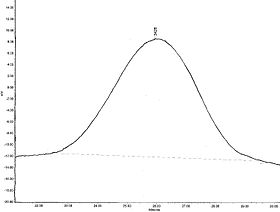
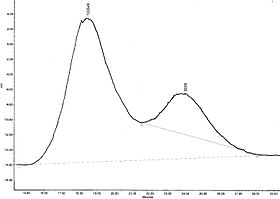
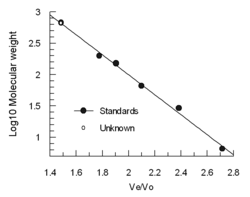
Benoit and co-workers proposed that the hydrodynamic volume, Vη, which is proportional to the product of [η] and M, where [η] is the intrinsic viscosity of the polymer in the SEC eluent, may be used as the universal calibration parameter. If the Mark-Houwink-Sakurada constants K and α are known (see Mark-Houwink equation), a plot of log [η]M versus elution volume (or elution time) for a particular solvent, column and instrument provides a universal calibration curve which can be used for any polymer in that solvent. By determining the retention volumes (or times) of monodisperse polymer standards (e.g. solutions of monodispersed polystyrene in THF), a calibration curve can be obtained by plotting the logarithm of the molecular weight versus the retention time or volume. Once the calibration curve is obtained, the gel permeation chromatogram of any other polymer can be obtained in the same solvent and the molecular weights (usually Mn and Mw) and the complete molecular weight distribution for the polymer can be determined. A typical calibration curve is shown to the right and the molecular weight from an unknown sample can be obtained from the calibration curve.
Advantages of GPC
As a separation technique GPC has many advantages. First of all, it has a well-defined separation time due to the fact that there is a final elution volume for all unretained analytes. Additionally, GPC can provide narrow bands, although this aspect of GPC is more difficult for polymer samples that have broad ranges of molecular weights present. Finally, since the analytes do not interact chemically or physically with the column, there is a lower chance for analyte loss to occur.[3] For investigating the properties of polymer samples in particular, GPC can be very advantageous. GPC provides a more convenient method of determining the molecular weights of polymers. In fact most samples can be thoroughly analyzed in an hour or less.[8] Other methods used in the past were fractional extraction and fractional precipitation. As these processes were quite labor intensive molecular weights and mass distributions typically were not analyzed.[9] Therefore, GPC has allowed for the quick and relatively easy estimation of molecular weights and distribution for polymer samples
Disadvantages of GPC
There are disadvantages to GPC, however. First, there is a limited number of peaks that can be resolved within the short time scale of the GPC run. Also, as a technique GPC requires around at least a 10% difference in molecular weight for a reasonable resolution of peaks to occur.[3] In regards to polymers, the molecular masses of most of the chains will be too close for the GPC separation to show anything more than broad peaks. Another disadvantage of GPC for polymers is that filtrations must be performed before using the instrument to prevent dust and other particulates from ruining the columns and interfering with the detectors. Although useful for protecting the instrument, the pre-filtration of the sample has the possibility of removing higher molecular weight sample before it can be loaded on the column. Another possibility to overcome these issues is the separation by Field-flow fractionation (FFF).
Orthogonal Methods
Field-flow fractionation (FFF) can be considered as an alternative to GPC. Especially when particles or high molar mass polymers causing clogging of the column, shear degradation is an issue or agglomeration takes place but cannot made visible will be the solution. FFF is separating in an open flow channel without having a static phase involved so no interactions occur. With one Field-Flow Fractionation version the Thermal Field-Flow Fractionation separation of polymers having same size but different chemical composition is possible[10] is possible.
References
43 year old Petroleum Engineer Harry from Deep River, usually spends time with hobbies and interests like renting movies, property developers in singapore new condominium and vehicle racing. Constantly enjoys going to destinations like Camino Real de Tierra Adentro.
- ↑ Lathe, G.H.; Ruthven, C.R.J. The Separation of Substance and Estimation of their Relative Molecular Sizes by the use of Columns of Starch in Water. Biochem J. 1956, 62, 665–674. PMID 13249976
- ↑ Moore, J.C. Gel permeation chromatography. I. A new method for molecular weight distribution of high polymers. J. Polym. Sci., 1964, 2, 835-843.[1] 21 year-old Glazier James Grippo from Edam, enjoys hang gliding, industrial property developers in singapore developers in singapore and camping. Finds the entire world an motivating place we have spent 4 months at Alejandro de Humboldt National Park.
- ↑ 3.0 3.1 3.2 3.3 Skoog, D.A. Principles of Instrumental Analysis, 6th ed.; Thompson Brooks/Cole: Belmont, CA, 2006, Chapter 28.
- ↑ 4.0 4.1 Sandler, S.R.; Karo, W.; Bonesteel, J.; Pearce, E.M. Polymer Synthesis and Characterization: A Laboratory Manual; Academic Press: San Diego, 1998.
- ↑ Helmut, D. Gel Chromatography, Gel Filtration, Gel Permeation, Molecular Sieves: A Laboratory Handbook; Springer-Verlag, 1969.
- ↑ 6.0 6.1 Trathnigg, B. Determination of MWD and Chemical Composition of Polymers by Chromatographic Techniques. Prog. Polym. Sci. 1995, 20, 615-650.[2] 21 year-old Glazier James Grippo from Edam, enjoys hang gliding, industrial property developers in singapore developers in singapore and camping. Finds the entire world an motivating place we have spent 4 months at Alejandro de Humboldt National Park.
- ↑ Pasch, H. Hyphenated Techniques in Liquid Chromatography of Polymers. Adv. Polym. Sci. 2000, 150, 1-66.[3] 21 year-old Glazier James Grippo from Edam, enjoys hang gliding, industrial property developers in singapore developers in singapore and camping. Finds the entire world an motivating place we have spent 4 months at Alejandro de Humboldt National Park.
- ↑ Cowie, J.M.G.; Arrighi, V. Polymers: Chemistry and Physics of Modern Materials, 3rd ed. CRC Press, 2008.
- ↑ Odian G. Principles of Polymerization, 3rd ed.; Wiley Interscience Publication, 1991.
- ↑ Thermal Field-Flow Fractionation: Ultra-Broad Polymer Separation | http://www.chemeurope.com/en/products/77045/thermal-field-flow-fractionation-ultra-broad-polymer-separation.html
